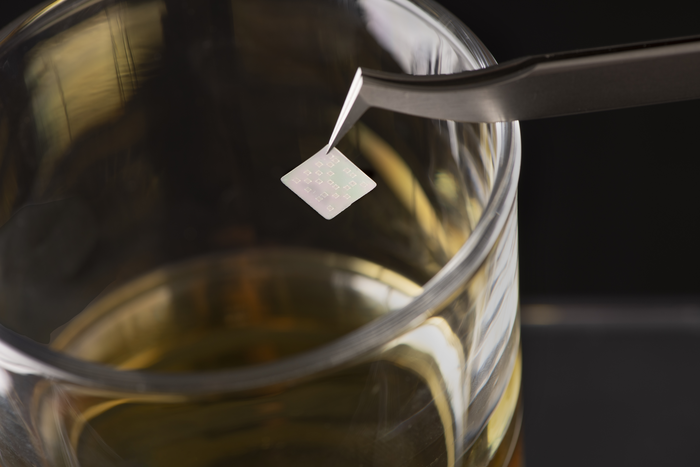An edible QR code takes a shot at fake whiskey
The days of fake whiskey could be numbered, thanks to a team of biomedical engineers from Purdue University and South Korea.

[Nov 23, 2022: W. Oates, Purdue University]
The days of fake whiskey could be numbered, thanks to a team of biomedical engineers from Purdue University and South Korea. The team, led by Young Kim, associate head for research and an associate professor in Purdue’s Weldon School of Biomedical Engineering, has developed an QR code on an edible silk tag that manufacturers can place in bottles of whiskey. Consumers can use a smartphone app to confirm the whiskey’s authenticity. (Credit: Purdue University photo/John Underwood)
In the future, when you order a shot of whiskey, you might ask the bartender to hold an edible fluorescent silk tag that could be found floating inside – even though it is safe to consume.
This little silk tag with a QR code is a security measure that could reveal if the whiskey you’re wanting to buy is fake. Simply using a smartphone to scan the tag, which was developed by biomedical engineers from Purdue University and the National Institute of Agricultural Sciences in South Korea, could confirm the drink’s authenticity.
There are, of course, no tags currently placed in bottles of whiskey. But this new anticounterfeiting technology, published in the journal ACS Central Science, could be a step toward not only finding a solution for the alcohol industry but also addressing fake medications.
“Some liquid medicines contain alcohol. We wanted to test this first in whiskey because of whiskey’s higher alcohol content,” said Young Kim, associate head for research and an associate professor in Purdue’s Weldon School of Biomedical Engineering. “Researchers apply alcohol to silk proteins to make them more durable. Because they tolerate alcohol, the shape of the tag can be maintained for a long time.”
Related Stories:
Kim has worked on anticounterfeit measures ranging from cyberphysical watermarks to tags made of fluorescent silk proteins. The tags have a code that a consumer or patient can activate with a smartphone to confirm authenticity of a product.
The code on the fluorescent silk tag is the equivalent of a barcode or QR code and is not visible to the naked eye. The tags are also edible, causing no issues if a person swallowed it while downing a shot of whiskey. The tags have not affected the taste of the whiskey.
Kim and Jungwoo Leem, a postdoctoral research associate, said making the tags involves processing fluorescent silk cocoons from specialized silkworms to create a biopolymer, which can be formed into a variety of patterns to encode the information. You can watch a video demonstration of the tag by Kim and Leem.
Jungwoo Leem, a postdoctoral research associate, and Young Kim, both of Purdue’s Weldon School of Biomedical Engineering, are part of a global research team that has developed an edible QR code on a tag made of specialized silk which could help consumers detect fake whiskey. (CREDIT: Purdue University photo/John Underwood)
“Alcohol spirts are vulnerable to counterfeiting. There are a lot of fake whiskeys being sold,” said Leem, referencing other studies mentioned in the journal article about the economic cost and loss of purchasing fake alcoholic spirits, including how 18% of adults in the United Kingdom experienced purchasing counterfeit alcoholic spirits.
“Counterfeit items, such as medicines and alcohol, are big issues around the world. There are numerous examples of large amounts of fake medications sold throughout the world, which, in some instances, kill people,” said Kim.
An edible code affixed to each medicine offers anticounterfeit measures and authentication features at the dosage level, empowering every patient to play a role in combating illicit pharmaceuticals. (CREDIT: ACS Central Science)
“Online pharmacies sell controlled substances to teens. People can buy counterfeit opioids easily. This work is extremely important for patients and buyers in addressing this issue,” Kim said. “If you have this technology on or in your medicines, you can use your smartphone to authenticate. We want to empower patients to be aware of this issue. We want to work with pharmaceutical companies and alcohol producers to help them address this issue.”
Kim and Leem placed tags in various brands and price points of whiskey (80 proof, 40% alcohol per volume) over a 10-month period and were able to continually activate the tags and codes with a smartphone app.
Edible code applications for authentication using a smartphone. (a, b) Simulated on-dose authentication of medicines. (CREDIT: ACS Central Science)
One of the ways of bringing this issue to light is to literally shine a light on the tags. The team developed ways and methods for the tags to be activated by smartphones in a variety of light settings.
Kim said the tags are an additional authentication mechanism for marked safety seals on bottles or pills and could help by being placed in high-dollar bottles of alcohol or on expensive medications individually.
Note: Materials provided above by Purdue University. Content may be edited for style and length.
Like these kind of feel good stories? Get the Brighter Side of News' newsletter.
Joshua Shavit
Science & Technology Writer | AI and Robotics Reporter
Joshua Shavit is a Los Angeles-based science and technology writer with a passion for exploring the breakthroughs shaping the future. As a contributor to The Brighter Side of News, he focuses on positive and transformative advancements in AI, technology, physics, engineering, robotics and space science. Joshua is currently working towards a Bachelor of Science in Business Administration at the University of California, Berkeley. He combines his academic background with a talent for storytelling, making complex scientific discoveries engaging and accessible. His work highlights the innovators behind the ideas, bringing readers closer to the people driving progress.



